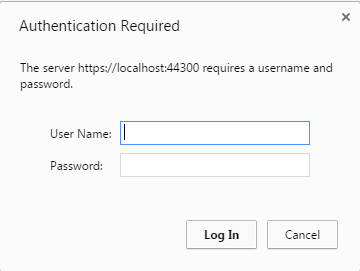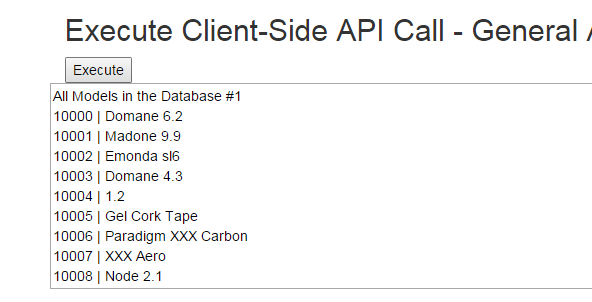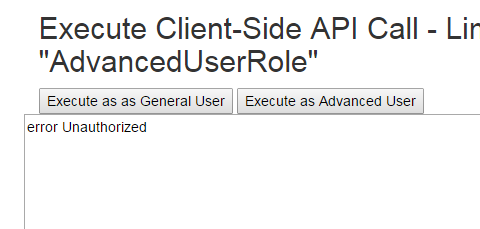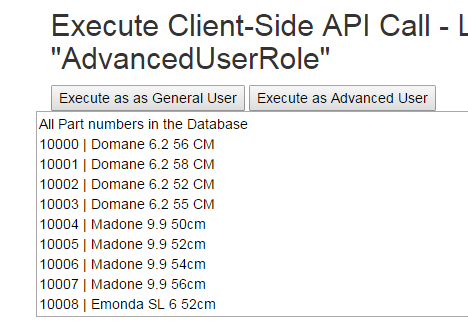In the previous article on Web API, I demonstrated simple CRUD operations. In this article I implement a security scheme using Basic Authentication. While investigating authentication options, I was first dismissive of Basic Authentication. Sending credentials with every request that could easily be read doesn’t seem like a very secure approach. Then I found a blog post by @rdegges that raised some good points. Essentially, basic authentication can be a valid technique if you:
- Require HTTPS
- Use random key pairs for the API
- Generate unique key pairs for each client application
- Provide some mechanism of allowing clients to revoke / request their keys.
However, if you’re planning on using the API as a back end for a front-end client, basic authentication is not a good choice. Somewhere, your JavaScript will need to set the credentials on the API call, and to my knowledge, you can’t easily (possibly?) store that on the client in a secure manner. In these cases you should stick to a session ID / token approach. To put it another way, Basic Authentication should not be used unless the credentials can be stored in secure manner. Later on I demonstrate this on the server end using a pass-thru API call, as if I was calling some third party API service on behalf of the client.
Source is up on Github
Custom Filters for Authentication
Setting up basic authentication was slightly complicated. The Web API / MVC frameworks do not support basic authentication as one of the default wizard options - you need to include custom code in your app. You have the choice of either writing a custom HTTP Module, or using the newer Web API Filter approach. I ended up using this BasicAuthenticationAttribute filter from www.asp.net / Codeplex.
Additionally, I also wanted to force HTTPS, and I was able to find another filter to copy from this www.asp.net article.
Security Approach
The basic security scheme I used is as follows:
To use the identity database, I created a new security context and database. I added the users in the seed() method and updated using migrations.
Controllers
The controllers are essentially the same as in the prior article
Each controller has been decorated with three attributes
namespace WebApiBasicAuthentication.Controllers
{
[IdentityBasicAuthentication] // Enable Basic authentication for this controller.
[RequireHttps]
[Authorize] // Require authenticated requests.
public class ModelsController : ApiController
{
For the restricted controller, you simply include the roles in the Authorize Attributes
namespace WebApiBasicAuthentication.Controllers
{
[IdentityBasicAuthentication] // Enable Basic authentication for this controller.
[RequireHttps]
[Authorize (Roles = "AdvancedUserRole")] // Require authenticated requests + user in specified role
public class PartNumbersController : ApiController
{
The new controller I added to this project was to demonstrate calling a third party service. As I mentioned earlier, this would be a valid place to call an API using basic authentication, as the client has no knowledge of the credentials. In this case the “third party service” is simply another controller in the project, but you get the idea.
namespace WebAPIBasicAuthentication.Controllers
{
public class PartNumberPassThruController : ApiController
{
public async Task<HttpResponseMessage> GetPartNumbers()
{
HttpResponseMessage response = null;
string json = "";
string apiKey = "7f5645122a634577a53dca81359138b6";
string apiSecret = "3186b763ddb4405bbf0b0d0eac5892cf";
using (var client = new HttpClient())
{
client.BaseAddress = new Uri(Request.RequestUri.GetLeftPart(UriPartial.Authority));
client.DefaultRequestHeaders.Accept.Clear();
client.DefaultRequestHeaders.Accept.Add(new MediaTypeWithQualityHeaderValue("application/json"));
client.DefaultRequestHeaders.Authorization =
new AuthenticationHeaderValue(
"Basic",
Convert.ToBase64String(
System.Text.ASCIIEncoding.ASCII.GetBytes(
string.Format("{0}:{1}", apiKey, apiSecret)))
);
response = await client.GetAsync("api/PartNumbers");
if (response.IsSuccessStatusCode)
{
return response;
}
}
return Request.CreateResponse(HttpStatusCode.NotFound);
}
}
}
If the third party api returns JSON, you may choose to pass this directly to the client. Or, you may choose to load into objects for further manipulation, filtering, etc.
Examples
The website root contains a number of sample tests
Test #1 - Access the API directly via browser
https://localhost:44300/api/models
If you access this before other tests, you will be prompted to enter a username / password.
With basic authentication, the browser caches those credentials, and they will be sent with each request.
Here’s what the header looks like (remember that the string after Basic is simply a base64 encoded version of the username/password):
Test #2 - Execute Client-Side API Call that is valid for any authenticated user
//General User
var apiKey = "5b2025f5c0c847b788545cce506ce6eb";
var apiSecret = "556038b0a8d943caaf1c1ddfab70f956";
$.ajax({
type: "GET",
url: "/api/models",
dataType: "json",
async: false,
username: apiKey,
password: apiSecret,
data: "",
success: function (data) {
$('#ClientOutputGeneralAccess').html("");
$('#ClientOutputGeneralAccess').append('All Models in the Database #1 \r\n');
$.each(data, function (key, item) {
$('#ClientOutputGeneralAccess').append(item.ModelId + " | " + item.Name + '\r\n');
});
},
error: function (XMLHttpRequest, status, error) {
$('#ClientOutputGeneralAccess').html("");
$('#ClientOutputGeneralAccess').append(status + " " + error);
}
});
Test #3 - Execute Client-Side API Call that requires user to be in a Role
The /api/PartNumbers route is restricted. The first part of this test demonstrates what happens when a user not in the AdvancedUserRole tries to request this route.
// general user
var apiKey = "5b2025f5c0c847b788545cce506ce6eb";
var apiSecret = "556038b0a8d943caaf1c1ddfab70f956";
$.ajax({
type: "GET",
url: "/api/PartNumbers",
dataType: "json",
async: false,
username: apiKey,
password: apiSecret,
data: "",
success: function (data) {
$('#ClientOutputLimitedAccess').html("");
$('#ClientOutputLimitedAccess').append('All Part numbers in the Database \r\n');
$.each(data, function (key, item) {
$('#ClientOutputLimitedAccess').append(item.PartNumberId + " | " + item.InvoiceDescription + '\r\n');
});
},
error: function (XMLHttpRequest, status, error) {
$('#ClientOutputLimitedAccess').html("");
$('#ClientOutputLimitedAccess').append(status + " " + error);
}
});
Now the call is made using credentials in the AdvancedUserRole:
//Advanced user
var apiKey = "7f5645122a634577a53dca81359138b6";
var apiSecret = "3186b763ddb4405bbf0b0d0eac5892cf";
$.ajax({
type: "GET",
url: "/api/PartNumbers",
dataType: "json",
async: false,
username: apiKey,
password: apiSecret,
data: "",
success: function (data) {
$('#ClientOutputLimitedAccess').html("");
$('#ClientOutputLimitedAccess').append('All Part numbers in the Database \r\n');
$.each(data, function (key, item) {
$('#ClientOutputLimitedAccess').append(item.PartNumberId + " | " + item.InvoiceDescription + '\r\n');
});
},
error: function (XMLHttpRequest, status, error) {
$('#ClientOutputLimitedAccess').html("");
$('#ClientOutputLimitedAccess').append(status + " " + error);
}
});
Test #4 - Execute a Server-Side API call
The final test is for the pass-thru call. Notice there is no API key / credentials in this call. The restricted /api/partnumbers route is being accessed on the server.
// server side call
$.ajax({
type: "GET",
url: "/api/PartNumberPassThru",
dataType: "json",
async: false,
data: "",
success: function (data) {
$('#ServerOutput').html("");
$('#ServerOutput').append('All Part numbers in the Database \r\n');
$.each(data, function (key, item) {
$('#ServerOutput').append(item.PartNumberId + " | " + item.InvoiceDescription + '\r\n');
});
},
error: function (XMLHttpRequest, status, error) {
$('#ServerOutput').html("");
$('#ServerOutput').append(status + " " + error);
}
});





